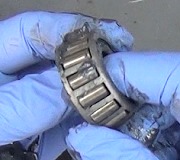The rotor is clamped in place by the wheel and lug nuts. As long as you can push the rotor straight after the caliper is bolted up, it should be fine. If you cannot do that, the most common cause is the caliper is not mounted correctly. The second possibility is some applications use one of two different-size rotors, and the wrong one is being installed.
There should be a light coating of high-temperature brake grease where the rotor's center hole contacts the hub. That will prevent a possible crunching sound when turning a corner puts a side load on the bearing.
Once everything is assembled, you will need to pump the brake pedal to run the pistons out of the caliper housings until the pads contact the rotors. This is where a lot of do-it-yourselfers and inexperienced mechanics cause a problem. Crud and corrosion build up in the lower halves of the bores in the master cylinder where the pistons do not normally travel. Pushing the brake pedal all the way to the floor, whether running the pistons out of the calipers or when surprised by a sudden leak, runs the rubber lip seals over that crud and can rip them. That results in a slowly-sinking brake pedal that often takes two or three days to show up. To prevent this damage, never push the brake pedal more than about half way to the floor, unless the master cylinder is less than about a year old.
Tuesday, December 12th, 2017 AT 1:31 PM


